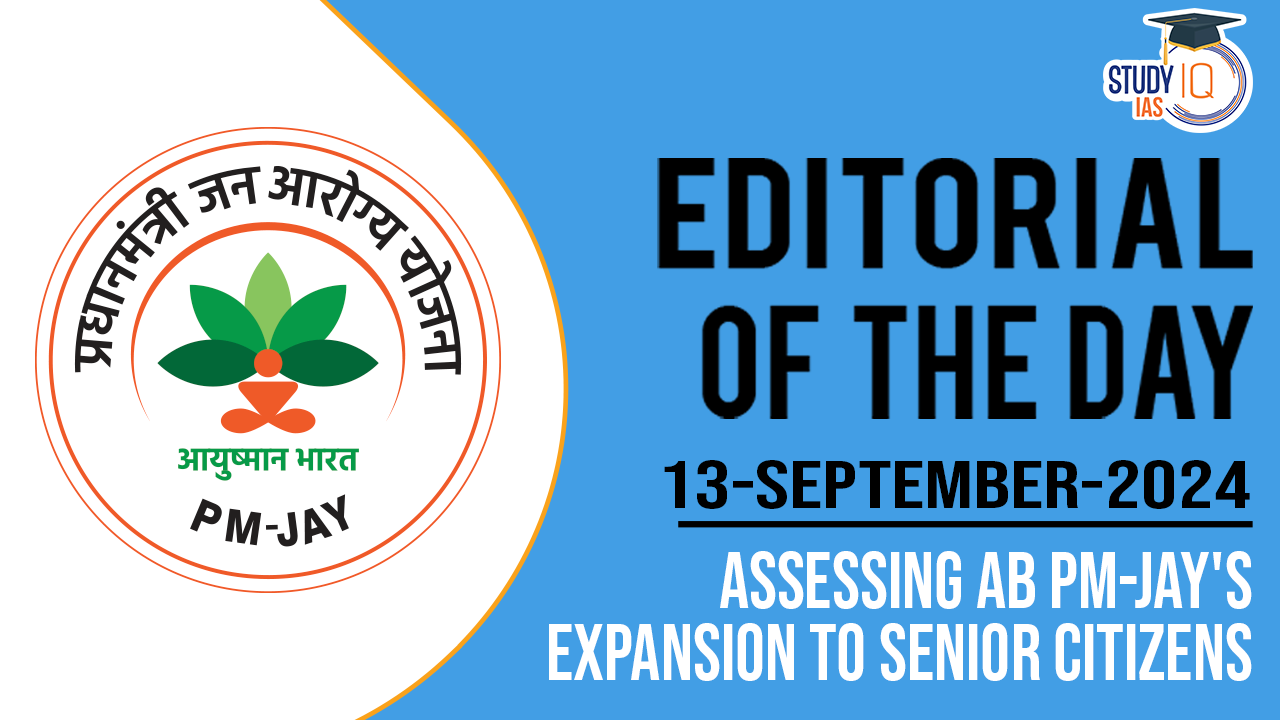Table of Contents
Context: Recently, the Union cabinet has approved an expansion of the Ayushman Bharat Pradhan Mantri Jan Arogya Yojana (AB PM-JAY) health cover to include all Indians aged 70 years and above, irrespective of their income.
Key Features of the Expanded AB PM-JAY Scheme
- Health Coverage for All Elderly Citizens: The expanded scheme will provide free health insurance cover of up to ₹5 lakh annually to all individuals aged 70 or older, including pre-existing conditions, without any exclusions or waiting periods.
- Registration Process: Eligible individuals can register via the Ayushman Bharat app or at Ayushman Bharat counters at government health facilities.
- Registration will require eKYC and will use face-authentication technology to accommodate elderly individuals whose fingerprints may be unreadable.
- This step is expected to benefit about 6 crore people, approximately 5% of India’s current population.

Benefits and Coverage Details
- ₹5 Lakh Annual Coverage: The cover will be shared within the family, meaning multiple elderly beneficiaries in a household will split the amount.
- Top-up for Existing Beneficiaries: Elderly members of families already covered by the scheme will receive an additional ₹5 lakh top-up specifically for their healthcare needs.
- Re-registration is required for the top-up.
- Existing Procedures and Expansion: AB PM-JAY currently covers 1,670 procedures across 26 specialities, including 25 geriatric packages. More elderly-specific packages are being added.
Coverage for Other Schemes
- Government Health Schemes: Approximately 80 lakh individuals are covered by other government schemes, such as the Central Government Health Scheme (CGHS), Ex-Servicemen Contributory Health Scheme, and schemes for defence and railway personnel.
- These individuals can choose between their current coverage or Ayushman Bharat.
- Employees State Insurance Corporation (ESIC): Those covered by ESIC can avail both ESIC and Ayushman Bharat coverage since ESIC premiums are paid by the insured and their employer, not the government.
- Private Insurance Holders: Individuals with private insurance can also avail themselves of Ayushman Bharat coverage.
Financial Implications and Government Support
- Initial Government Outlay: The central government will initially allocate ₹3,437 crore to cover the scheme’s costs for six months of the current financial year and the entirety of the next year.
- State Contributions: States are required to contribute 40% of the total cost.
| Note |
| The scheme has not been implemented in Delhi, West Bengal, and Odisha. However, Odisha is currently in talks to launch the scheme. |
Significance of the Scheme for India’s Elderly Population
- Ageing Population in India: India’s population is ageing rapidly, with individuals aged 60 or older expected to grow from 8.6% of the population in 2011 to 19.5% by 2050.
- This equates to an increase from 103 million in 2011 to 319 million by 2050.
- Healthcare Needs of the Elderly: The elderly are more likely to be hospitalised, with a higher rate of admission (7%) compared to younger people (3-4%) under the scheme.
- Current Coverage Gaps: Only 20% of India’s population aged 60 and above is covered by any health scheme, whether government, employer-provided, or personal insurance.
- The elderly, particularly women, remain largely uncovered by healthcare schemes.
- Gender Disparity: Women make up 58% of the elderly population, and 54% of these women are widows, often without healthcare support.
- The expansion of AB PM-JAY is expected to be especially beneficial for elderly women, particularly widows.
Challenges in Implementation and Doctor-Patient Asymmetry
- Issues with Claim Processing: Investigations have revealed that some doctors, especially in premier government hospitals, misinform families about delays in availing benefits under AB-PMJAY, often deterring them from accessing the scheme.
- Staff Reluctance: Overburdened hospital staff are often reluctant to fill out insurance paperwork, complicating the process for families.
- Role of Arogya Mitras: These healthcare counsellors are limited to registering claims but are not empowered to assist patients throughout the claim process.
- Limited to Hospitalisation (Secondary and Tertiary Care):The scheme covers excluded essential outpatient care, diagnostics, and medicines.
- With the rising incidence of chronic diseases, particularly among those aged 70 and above, a large portion of health expenditure (40%-80%) is on outpatient care.
- Low Penetration in Smaller Cities and Towns: Especially outside southern India where public primary and secondary healthcare infrastructure is inadequate.
- Private Sector Overload: Two-thirds of total spending under PM-JAY has gone to private hospitals, which indicates an over-reliance on private players.
- In southern states, 53% of the scheme’s funds go to private hospitals.
- Over-reliance on Insurance Model: Following an insurance-based model similar to the U.S. might lead to surging healthcare costs rather than achieving universal health coverage.
Lessons and Recommendations
- Empowering Counsellors: Empowering healthcare counsellors (Arogya Mitras) to assist patients beyond the registration of claims could resolve some procedural inefficiencies.
- Addressing Doctor-Patient Asymmetry: Narrowing the gap between doctors and patients through better communication and support systems is crucial for improving healthcare access.
NITI Aayog Recommendations
- Nuclear Families and Elderly Care: A position paper by NITI Aayog released highlighted the changing family structures, where nuclear families are increasingly prevalent. This necessitates easier access to quality healthcare, particularly for senior citizens.
- Healthcare Infrastructure: Beyond financial assurance, there is an urgent need to expand healthcare infrastructure, ensuring sufficient healthcare centres and adequate facilities tailored to the elderly population.
Conclusion
The expansion of the Ayushman Bharat health scheme to cover all individuals aged 70 years and older is a crucial step toward addressing India’s ageing population’s healthcare needs. The scheme’s wide coverage and its emphasis on eliminating barriers like pre-existing conditions and registration issues will help ensure better access to healthcare for the elderly, particularly women and other vulnerable groups.


 SHANTI Bill 2025: India Opens Nuclear Se...
SHANTI Bill 2025: India Opens Nuclear Se...
 Revamp of MGNREGA Scheme 2025
Revamp of MGNREGA Scheme 2025
 National Energy Conservation Awards 2025
National Energy Conservation Awards 2025

























